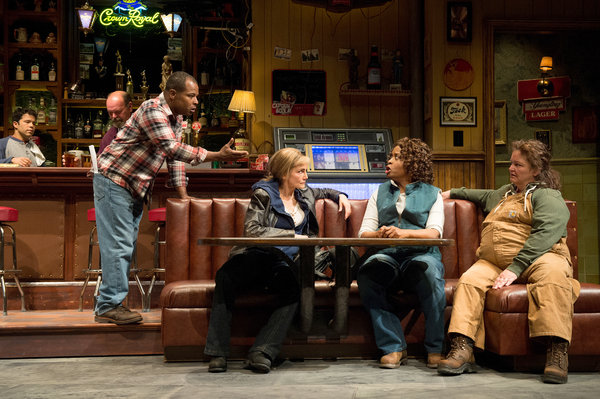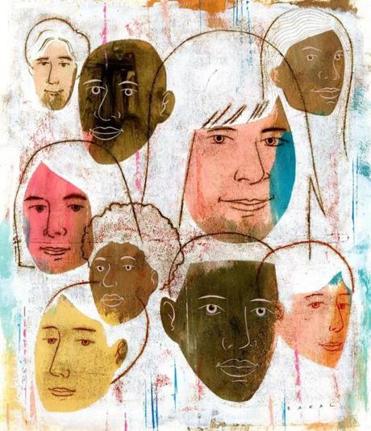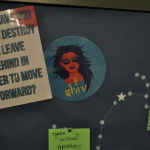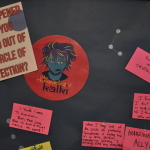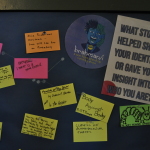In this Boston Globe article, writer Joel Brown interviews our very own Ilana Brownstein, Jessie Baxter, and Shawn LaCount in addition to other prominent dramaturgs in the Boston theatre such as A. Nora Long, Charles Haugland, and Ryan McKittrick about the rising importance of dramaturgy in theatre, especially in the Boston theatre scene and the creation of new work. Company One playwright Kirsten Greenidge is also interviewed in this article regarding dramaturgy on Splendor. Here is the link to the article, and the full text is quoted below.
The posters and programs for Company One’s “Splendor” last fall offered three credits where there are usually two:
“A WORLD PREMIERE by Kirsten Greenidge
Directed by Shawn LaCount
Dramaturgy by Ilana M. Brownstein”
Playwrights and directors always get prominent credits, but a dramaturg almost never does. The billing for Brownstein was one outward sign of a backstage shift in Boston theater.
“The role of the dramaturg was, really, we saw it as a third collaborator,” said LaCount, Company One’s artistic director.
But it’s a job that’s at best dimly familiar to the audience. Partly that’s because the role of the dramaturg changes from show to show and company to company. Dictionaries broadly define dramaturgy as the art of dramatic representation. Even dramaturgs say the job is not easy to explain. In today’s theater, they do anything from mundane script management to researching a play’s historical background, from suggesting changes in a play’s structure to arranging post-show discussions with the audience.
“You ask 10 dramaturgs what they do, and you’ll get 17 answers,” said Brownstein, whose title at Company One is director of new work.
From a small-company production like “Splendor” to the Broadway-bound “The Gershwins’ Porgy and Bess,” dramaturgs have been shaping much of what Boston theater audiences see. LaCount and others say that a dramaturg is especially valuable to a new play, and that’s why dramaturgs have a higher profile here lately. “I think Boston is becoming a player in new work in the American theater, (and) it’s been a while,” said LaCount. “I think the role of the dramaturg is a lot more noticeable and valuable.”
The Literary Managers and Dramaturgs of the Americas will hold their annual conference here in June. “The theme of the conference is looking to the future to see where we are going,” says conference chairwoman Magda Romanska, an assistant professor at Emerson College and editor of an upcoming dramaturgy textbook. “I think it’s a really good moment for the field.”
Playwrights are artists and rightly protective of their creations. But Greenidge said she was happy to have Brownstein’s input during the development of “Splendor,” which is built around a Thanksgiving weekend and centers on ties of family and community.
“One thing Ilana brought up was, ‘Nobody ever has Thanksgiving dinner in your play — what does that mean?” Greenidge said. By the time of the premiere, the playwright added a brief, dreamlike scene in which all the characters come to the table to get a piece of pie before dispersing again.
Dramaturgy (it rhymes with clergy, though “dramaturg” is pronounced with a hard G) dates to Europe in the 1700s, when the first dramaturgs were sort of in-house critics. Formal dramatic structure was long their main concern. Now institutional dramaturgs may be involved in selecting plays for a company to produce; they often carry the job title of literary manager. Production dramaturgs work on a specific show. Some dramaturgs are freelance, some on staff. Duties and titles overlap.
In the modern era, dramaturgs are known mainly for researching the context of a play to ensure an accurate production, and to provide background information to cast and designers. They have long been considered “the in-house bookworm,” as one joked.
But even that role is not necessarily dull. “Today I’m reading all about S&M for ‘Venus in Fur,’ ” said Charles Haugland, dramaturg at the Huntington Theatre Company.
Dramaturgs enter the field in various ways, but few have had as consistent a path as Ryan McKittrick, director of artistic programs/dramaturg at the American Repertory Theater in Cambridge. “I sort of grew up in this theater,” he said.
McKittrick was an undergraduate at Harvard when he fell in love with ART’s work, studied dramaturgy at the ART Institute, and has worked with the company since he graduated in 2000. He works on projects developed sometimes over years at the theater, including 2011’s “The Gershwins’ Porgy and Bess” under artistic director Diane Paulus that made it to Broadway.
“When I was an undergraduate, I didn’t really know what dramaturgy was,” McKittrick said. “It provides an opportunity for someone who loves academic research but also loves the theater and wants to pursue a life in professional theater. And within the theater you get to do many, many different things.”
Most dramaturgs write program notes and organize post-show discussions. Their quest: “How do we deepen an audience’s connection to the material?” said A. Nora Long, a dramaturg whose job title is associate artistic director at the Lyric Stage Company of Boston.
On productions, a dramaturg may also be responsible for “moment-to-moment rehearsal stuff” that requires a deep knowledge of the script, Brownstein said. “Splendor” follows numerous characters in a fictional Boston suburb over decades, jumping back and forth in time. The cast rehearsed the scenes in the order in which they appear in the play, not in the order in which they happen. So the scene they were working on at any given time might hinge on developments not shown until later.
“So it was one of my jobs for every scene to be the person who was like, ‘Context! Here’s what you need to know,’ ” Brownstein said.
Playwright Walt McGough says he’s always happy to have a dramaturg on one of his productions because they can solve thorny problems. When his “Priscilla Dreams the Answer” was in rehearsal with Fresh Ink Theatre a couple of years ago, he and director Melanie Garber got along great except for “one moment where we just kept talking past each other,” McGough said via e-mail.
The issue on which they deadlocked: when to start playing a Belle and Sebastian song in the play’s final moments. Garber wanted to start at the beginning of the last scene, while McGough wanted to wait until the blackout, he explained.
“We were wasting time trying to explain to each other why one choice was right and the other was wrong,” McGough said. “The dramaturg, Jessie Baxter, was sitting and patiently watching us run around in circles. She spoke up and recommended splitting the difference, and beginning the cue about halfway through the scene, so that it underscored the final moments but didn’t kick in fully until the play had ended.”
That solved the problem perfectly, he said, and exemplified the value of having a dramaturg who “observes the entirety of a play and its production, instead of just one aspect, and makes sure that everything that happens is being done in service to the same viewpoint.”
Baxter also “dramaturgs” for Company One and is working on its production of Annie Baker’s “The Flick,” opening at the Modern Theater in February.
The job all depends on the play, the circumstances and who’s involved. Dramaturgs can be less needed on a well-known work, especially with an experienced director. “If we’re doing ‘Private Lives’ with [director] Maria Aitken, she’s done 12 Noel Coward plays, she doesn’t need me,” said the Huntington’s Haugland.
And there are some playwrights and directors who aren’t so enthused about what dramaturgs have to say. Playwright Richard Nelson gave a speech in New York in 2007 in which he deplored a “culture of ‘development’ ” in which playwrights are thought to need help to do their work.
Boston dramaturgs say it’s often the older generation that has an issue with their growing role.
“I have some people in my family who are theater practitioners,” said Long, “and when I told my uncle I was studying dramaturgy, he was like, ‘As a director, what would I possibly need a dramaturg for? I can do research.’
“But the thing you cannot do is be another pair of eyes,” Long said. “I think the best dramaturgical relationships are about finding a collaborator who knows as much about what you are attempting to do onstage as you do, but who is going to look at it from a different perspective.”
As devised theater and new technologies become more common, younger playwrights grow more comfortable with new kinds of collaboration, said Romanska, who had just returned from a theater festival in Krakow filled with experimental work. “The rigid division of roles, director/dramaturg/playwright, becomes more and more blurred as people move across boundaries,” she said.

